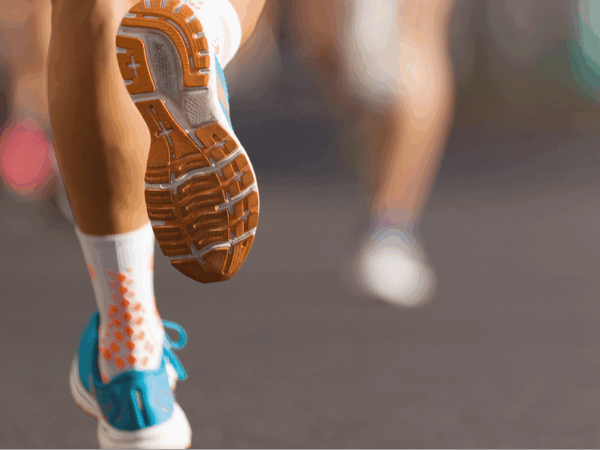What is low back pain?
Did you know 2 out of 3 women experience low back pain during pregnancy? It is a common problem that can prevent soon-to-be moms from working, doing activities they love and sleeping. The low back pain will also typically worsen as the pregnancy progresses, so it is important that pregnant women be proactive in their own low-back pain prevention and rehabilitation.
If you are a soon-to-be mom
There are many factors during pregnancy that may contribute to you experiencing low back pain. As your baby develops, your body goes through different changes:
- The increase in weight in your belly will also increase the natural curvature of your lower spine, which may shear the vertebrae and contribute to the existing pain.
- The hormone Relaxin, which increases during pregnancy to ready your body for delivery, loosens the ligaments and increases stress on the muscles of the low back and pelvis.
- Pre-pregnancy factors, including pelvic floor muscle weakness, hip tightness and muscular imbalances, may also play a role.
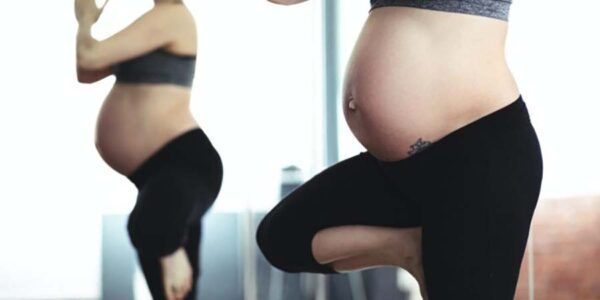
Good news! Exercise has been proven to help reduce and even prevent low back pain during pregnancy1,2! Furthermore, the Public Health Agency of Canada3 recommends exercise throughout pregnancy for other benefits such as:
- Increased energy levels.
- Enhanced sleep quality.
- Increased stamina for labour and delivery.
- Faster recovery after delivery.
Here are some exercises and tips for you soon-to-be mommies with low back pain to help get you back to your everyday activities and sleep better.
Exercices to do
Hanging stretch
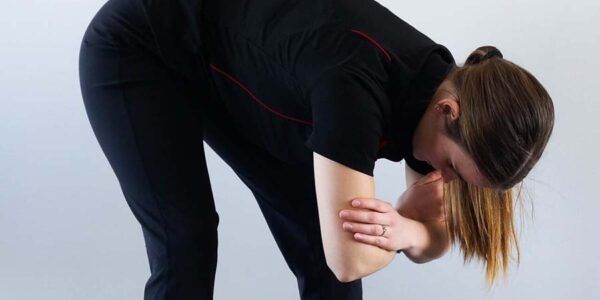
Place your feet wider than hip-width apart, bend your knees slightly and bend at the hips to curve your spine. Widen your stance to accommodate your belly if needed. Relax your lower back, shoulders and neck. Hold this position for 30 seconds, and repeat 2x.
Modified piriformis stretch
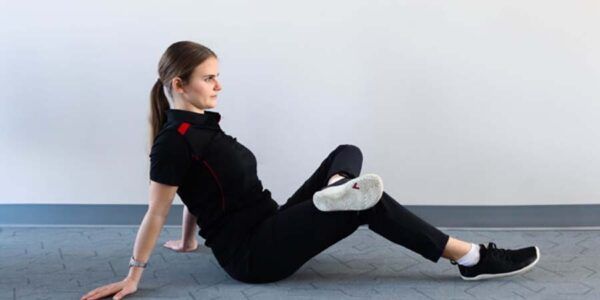
Sit on the floor with your knees bent and support yourself with your arms behind your back. Rest your foot across the opposite knee to feel a stretch in your glutes. Hold for 30 seconds and perform the stretch on the opposite leg. Repeat 2x.
Cat-cow stretch
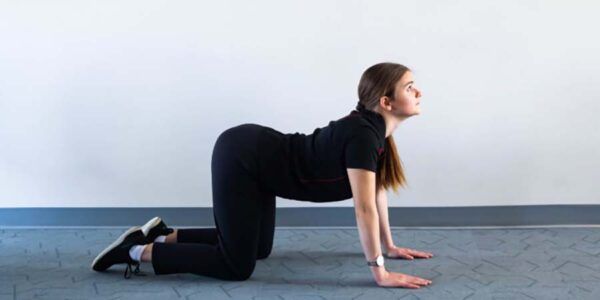
Place yourself in 4-pt, with your hands under your shoulder and knees under your hips. Curve your back, bringing your belly towards the floor, and look towards the ceiling. Hold this position for 10 seconds.
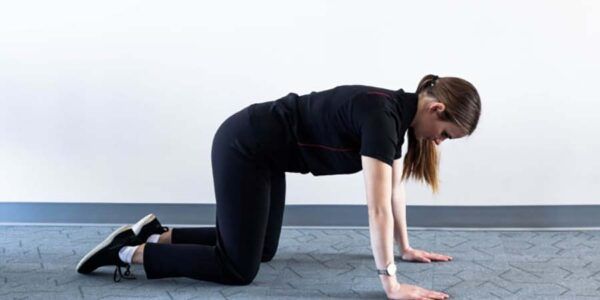
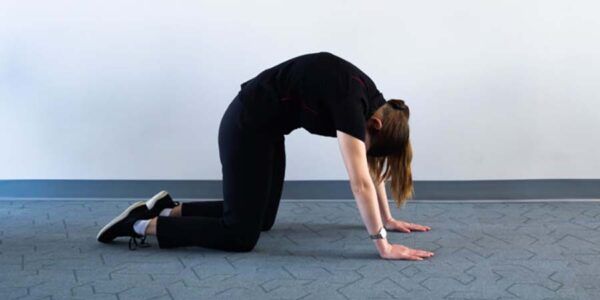
Then round your back, pulling your belly button up, towards the ceiling, and tuck your chin in. Hold this position for 10 seconds. Repeat these movements 10x.
Modified « Bird-dog »
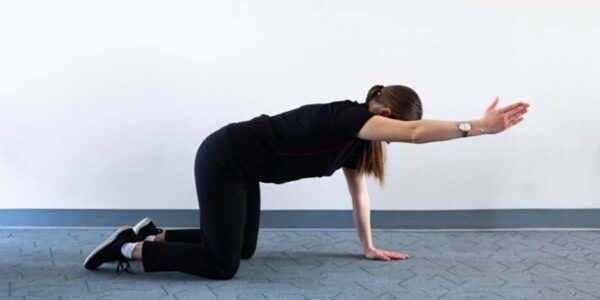
In the same 4-pt position, with a flat back, bring your belly button in towards your spine to engage the core. Slowly raise one arm parallel to the floor, and then lower it back down. Repeat 10x each arm, alternating between left and right arms.
Hip thrust on ball/chair
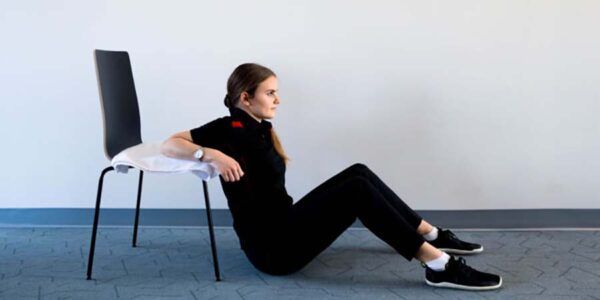
This exercise can be performed on an exercise ball placed against a wall, a couch, on the floor, or on a chair like shown in this image.
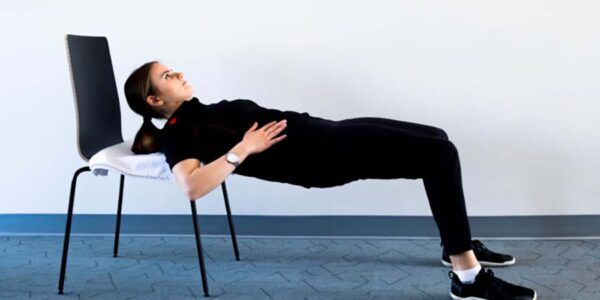
Place your shoulder blades on the ball, couch, or chair, or lay flat on your back with your hands at your side. Engage your core by bringing your belly button in towards your spine. Slowly lift your hips from the floor to a comfortable height, and lower down slowly. Repeat 15x.
Hip extension on ball/chair
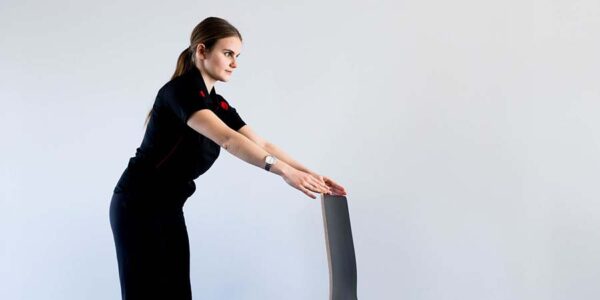
This exercise can also be performed kneeling with an exercise ball or standing with a chair as demonstrated in the image above.
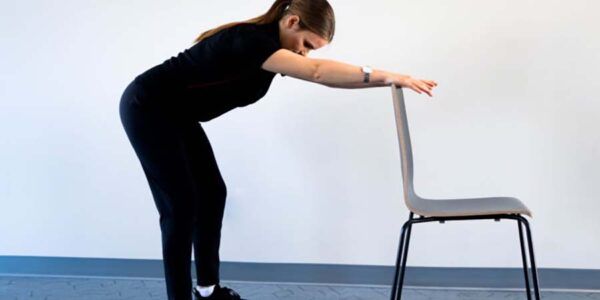
Place your feet wider than shoulder width apart, with your knees slightly bent and your arms resting on the back of the chair. Slowly bend at your hips, sit back and allow your arms to slide on the chair as you bend.
Remember to check with your doctor to make sure exercise is safe for you. Listen to your body – all exercises should be comfortable and should not increase your pain.
What should I do if my pain is persistent?
If after these exercises your low back pain persists, or if you are struggling with other common problems that occur during pregnancy such as pelvic pain or urinary incontinence, we recommend making an appointment with our pelvic floor physiotherapists who specialize in prenatal and postpartum care.
I am not sure if physiotherapy can help me. What can I do?
It is normal to have questions when trying something new. We now offer the possibility to schedule a free orientation call with a physiotherapist to help you decide if physiotherapy is right for you!
References
[:en]1. Sarah D Liddle, Victoria Pennick. Interventions for preventing and treating low‐back and pelvic pain during pregnancy. Cochrane Database of Systematic Reviews, 2015 2. Shiri R, Coggon D, Falah-Hassani K. Exercise for the prevention of low back and pelvic girdle pain in pregnancy: A meta-analysis of randomized controlled trials. Eur J Pain. 2018 Jan;22(1):19-27. doi: 10.1002/ejp.1096. Epub 2017 Sep 4. PMID: 28869318. 3. Public Health Agency of Canada. The Sensible Guide to a Healthy Pregnancy. Government of Canada 4. Mottola MF, Davenport MH, Ruchat S, et al. 2019 Canadian guideline for physical activity throughout pregnancy. British Journal of Sports Medicine 2018;52:1339-1346[:]



